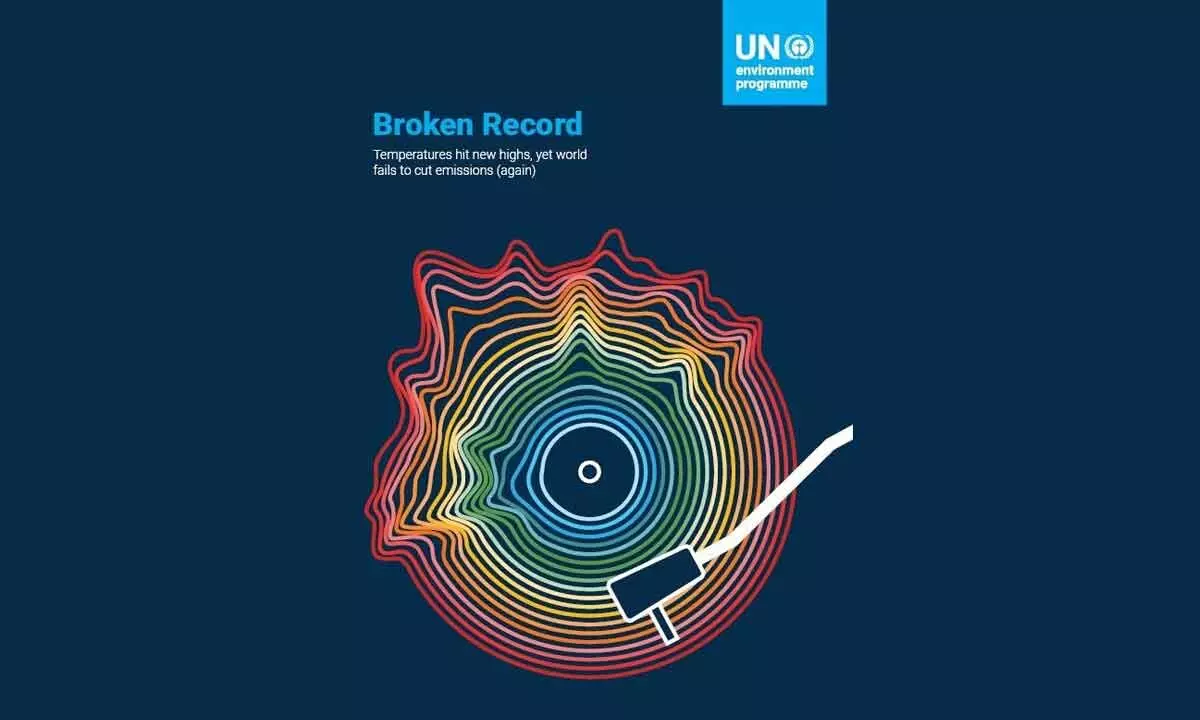Temperatures have hit new highs,but emissions remain uncut
The likelihood of limiting warming to 1.5°C levels is only 14 per cent
image for illustrative purpose

The UN Environment Programme released the 14th edition of its Emissions Gap Report 2023 on November 20. The report assesses the future trends in greenhouse emissions and looks into possible solutions to global warming.
This year's report finds that ‘temperatures have hit new highs, yet the world fails to cut emissions’.
This report released before COP 28, scheduled to be held from November 30-December 12, will be an eye-opener for all member countries as this calls for urgent adherence to the Paris Agreement and implementing the conditional and unconditional Nationally Determined Contributions (NDCs).
Given that despite fully implementing the guidelines, it still falls short of achieving 1.5°C, over pre-industrial levels, it calls for all nations to accelerate economy -wide, low carbon development transformations. A way forward will be in countries with a greater capacity and responsibility for emissions supporting developing nations as they pursue low-emission development growth.
The report finds that the world is heading towards a 2.5° -2.9°C temperature rise above industrial levels unless countries step up action and deliver more than the 2030 pledges under the Paris Agreement. The report stresses that the emissions by 2030 must be cut by at least 28-42 per cent compared to the current policy scenario to get on track for the 2°C and 1.5°C goals.
Enhanced action plans will facilitate more ambitious targets for 2035 in the next round of climate pledges and increase the chances of meeting the targetted net-zero.
By the commencement of October, around 86 days were recorded with temperatures that were over 1 5°C above pre-industrial levels as September was the hottest recorded month, with the global average temperatures at 1.8°C above pre-industrial levels. Worsening of this situation will have an adverse impact on nature and the environment. As it is, the GHG emissions registered an increase of 1.2 per cent last year. This indicates that the current plans are falling short.
Major findings in the report: 1. If the mitigation efforts under current policies are continued, global warming will be limited to 3°C above pre-industrial levels throughout this century; 2. Continuing efforts implied by unconditional NDCs can limit temperature rise to 2.9°C; 3. The additional achievement and continuation of conditional NDCs would lead to temperatures not exceeding 2.5°C above pre-industrial levels; 4. If all conditional NDCs and net-zero pledges are met, it is possible to limit the temperature rise to 2.0°C.
In a veiled warning the report states that net-zero pledges are not currently considered credible and no G20 member is reducing emissions at a pace that is consistent with net-zero targets. In the most optimistic scenario, the likelihood of limiting warming to 1.5°C levels is only 14 per cent. It is in this background that the report recommends the need to cut 2030 emissions by 28 per cent to get on a least cost-pathway for the 2.0°C goal of the Paris Agreement and 42 per cent for the 1.5°C goal. This recommendation implies stepping up efforts and enhanced goals and going about them with determined efforts.
Current and historical emissions are unequivocally distributed within and among countries, reflecting global pattern of inequality. The current level of GHG emissions (2021) of China with 30% population is 30%; USA 4% of population GHG emissions at 11%; EU 27 6% population with GHG of 7%; India with 18% of population 7% of GHG emissions; Russian Federation with 2% of population 5% of GHG emissions, Rest of G20 14% of population with 18% of GHG emissions, rest of world 24% of population 18% of GHG emissions while in the least developed countries with 14% of population have three per cent of GHG emissions.
Similarly in terms of current and historic contribution to climate change 1850 -2021 and contribution to warming 2850-2021 vary significantly across countries and groups of nations. Nearly 80 per cent of historical cumulative fossil and LULUCF CO2 emissions came from G20 countries with the largest contribution from China, the United States of America and European Union while least developed countries contributed four per cent. United States of America account for four per cent of the current population but contributed 17% if global warming from 1850-2021.
By contrast, India accounts for 18 per cent of the world population but it has till date contributed only five per cent of warming.
It is therefore expected that high income countries and high emitting countries, which bear the greatest responsibility for past emissions, should aim and implement accelerating domestic reduction emissions, committing to reach net-zero as soon as possible - and sooner than the global averages from the latest IPCC report implied- and at the same time providing financial and technical support to low and middle income countries, which account for the majority of current emissions.
Low and middle income countries should explore development without burning fossil fuels and take up alternative renewable energy options.
The report further suggests that delayed stringent mitigation actions will increase future dependence on carbon dioxide removal (CDR) from the atmosphere but availability of large scale CDR options in the future cannot be taken for granted.
In its conclusion, the report, vis-à-vis this year, dwells about opportunities and challenges associated with energy transitions as well as development and deployment of CDR.
In the COP 28, the first Global Stock-take (GST) will provide a framework for building new ambition. The countries should submit their next round of NDCs in 2025 with the target being for 2035.
The new NDCs should compensate for excess emissions and set new plans to achieve long-term temperature goals and restricting emissions consistent with the below 2°C and 1.5° C pathways.
We hope COP 28 will bear fruit and arrive at a consensus solution to pursue the revised goals with firm efforts and assure a safe life to the future generations.
(The author is former Chairman & Managing Director of Indian Overseas Bank)

